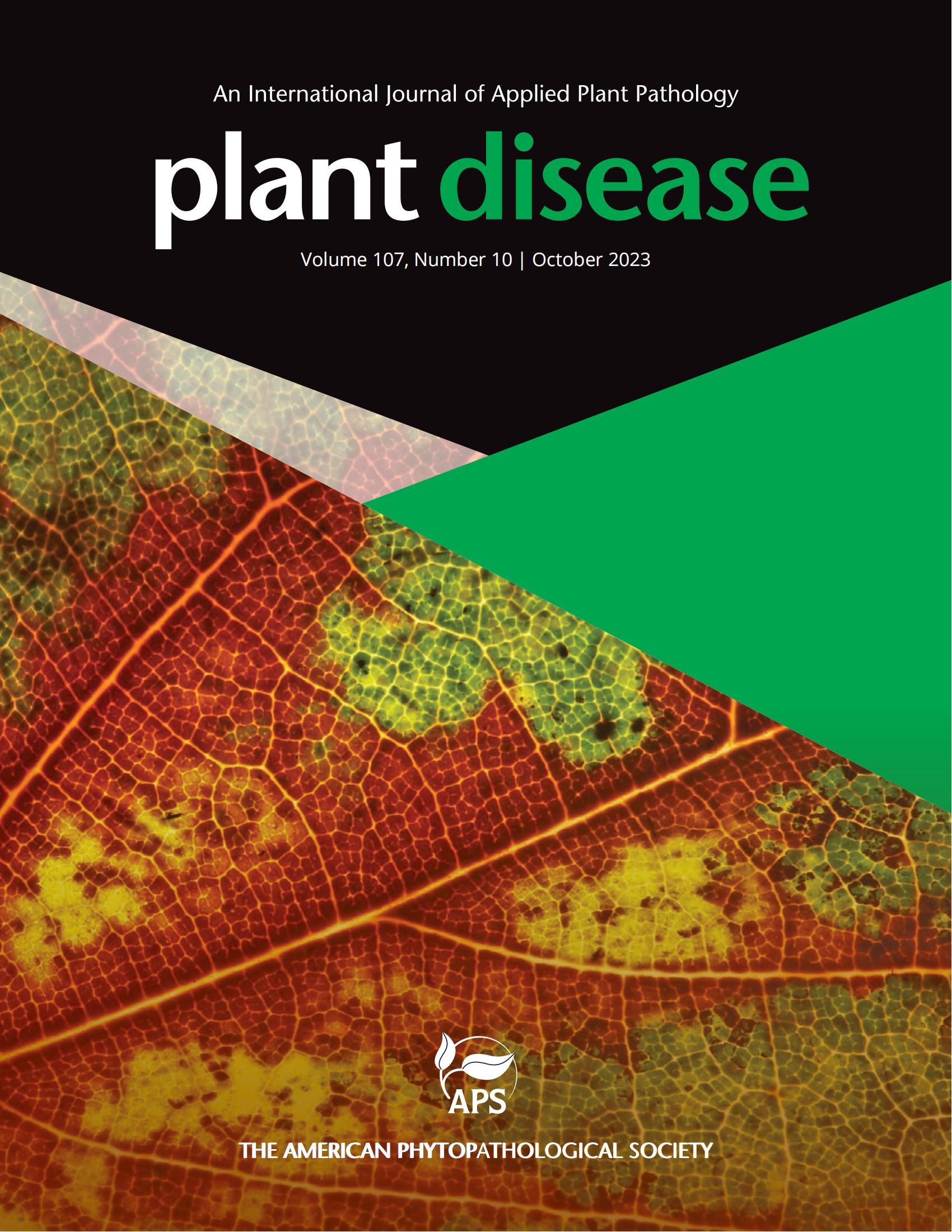江苏槭干叶斑病报道首例。
摘要
枫槭原产于中国,是一种具有较高经济价值的观赏树种。2022年9月,在江苏省林业科学研究院(118°45′517.30″E, 24 31°51′27.94″N)的苗圃中发现了一种新的白斑病。据统计,1600株白杨苗木中有62.5%患此病。最初的症状是在被感染的叶子上出现黑色到棕色的斑点。随后,斑点逐渐扩大到更大的区域,最后整个叶子变黄并脱落。收集病叶,从健康组织和病组织之间的边缘切除3 ~ 4mm的切片,75%乙醇消毒30秒,1.5% NaClO消毒90秒,消毒蒸馏水冲洗3次,涂于马铃薯葡萄糖琼脂(PDA)上,25℃黑暗孵育。通过单孢子分离获得纯培养物。从感染组织中获得6个形态特征相似的真菌培养物,占总分离物的70%。菌落最初为白色,但在黑暗中25°C孵育7天后变成深灰色。为了诱导产孢,将菌落培养在2%水琼脂上,在25°C UVA光下培养2周。分生孢子产生分生孢子,分生孢子透明,单细胞,不间隔,椭球状至梭形,外部光滑,薄壁,大小为15.3 ~ 20.4 × 4.5 ~ 7.4 μm (n=35,从两个选择的菌株中计算)。这些特征与Neofusicoccum sp. (Kirk et al. 2008)的描述一致。以分离株YBF2-1和YBF5-1为代表进行分子鉴定。利用引物对ITS1/ITS4 (White et al. 1990)、EF1- 728f /EF1- 986r (Alves et al. 2008)和Bt2a/Bt2b (Glass and Donaldson 1995)分别扩增了内部转录间隔区(ITS)、翻译延伸因子1-α基因(EF1-α)和β -微管蛋白基因(TUB2)。获得ITS (GenBank登记号:PP980685, PQ222752), EF1-α (PQ009204, PQ227810)和TUB2序列(编号:PP993456、PQ227811)与Neofusicoccum parvum的多个GenBank序列(ITS的MK370685、KC818612)的同源性均为bb0 99%;MH118932, KJ126847为EF1-α;TUB2分别为MN318109、OL456719)。将MEGA7中所有已测序的基因座进行组合,得到一个相邻连接的系统发育树。两株分离株经鉴定均为小奈瑟菌。为检测致病性,用无菌针在3个1月龄的白杨幼苗(每株5片)上接种20 μL分生孢子悬浮液(1×106孢子/mL),用分离物YBF2-1在叶片左侧接种15片叶片,同时在叶片右侧接种相同大小的灭菌水。每株单独用透明聚乙烯袋覆盖,在25℃下保持80%左右的相对湿度。接种5 d后,处理叶片左侧出现典型症状,右侧叶片(对照)无症状。接种试验进行了3次。随后,从三株接种的幼苗的六片叶子中重新分离并鉴定出相同的真菌。本研究为国际上首次报道在短毛蠓上发现小乳螨,为研究短乳螨的生物学和流行病学提供重要参考。Acer truncatum, originating in China, is an ornamental tree species with high economic value. In September 2022, a new leaf spot disease was observed on seedlings of A. truncatum in a tree nursery from the Jiangsu Academy of Forestry (118°45'517.30″E, 24 31°51'27.94″N) in China. According to statistics, 62.5% of 1600 A. truncatum seedlings suffered from the disease. The first symptoms were black to brown spots appearing on the infected leaves. Subsequently, the spots gradually expanded into larger areas, and finally the entire leaf turned yellow and fell off. The diseased leaves were collected and sections of 3 to 4 mm were excised from the margins between healthy and diseased tissues, surface sterilized in 75% ethanol for 30 sec. and 1.5% NaClO for 90 sec., rinsed three times in sterilized distilled water, plated on potato dextrose agar (PDA) and incubated at 25℃ in darkness. Pure cultures were obtained by monosporic isolation. Six fungal cultures with similar morphological characteristics were obtained from the infected tissues, and they accounted for 70% of the total isolates. Colonies were initially white but turned dark gray following 7 days of incubation at 25°C in the dark. To induce sporulation, colonies were grown on 2% water agar and incubated under UVA light at 25°C for two weeks. The conidiophores produced conidia, and conidia were hyaline, unicellular, nonseptate, ellipsoidal to fusiform, externally smooth, thin-walled, and were 15.3 to 20.4 × 4.5 to 7.4 μm (n=35, counted from the two selected isolates). These characteristics were consistent with the description of Neofusicoccum sp. (Kirk et al. 2008). Isolates YBF2-1 and YBF5-1 were selected as representative for molecular identification. The internal transcribed spacer region (ITS), the translation elongation factor 1-alpha gene (EF1-α), and the beta-tubulin gene (TUB2), using the primer pairs ITS1/ITS4 (White et al. 1990), EF1-728F/EF1-986R (Alves et al. 2008), and Bt2a/Bt2b (Glass and Donaldson 1995) were amplified, respectively. The obtained ITS (GenBank Accession No. PP980685, PQ222752), EF1-α (No. PQ009204, PQ227810), and TUB2 sequences (No. PP993456, PQ227811) all showed >99% homology with several GenBank sequences of Neofusicoccum parvum (MK370685, KC818612 for ITS; MH118932, KJ126847 for EF1-α; and MN318109, OL456719 for TUB2, respectively). A neighbor-joining phylogenetic tree was generated by combining all sequenced loci in MEGA7. The two isolates were identified as N. parvum. To test pathogenicity, 15 leaves on three one-month-old A. truncatum seedlings (five leaves from each seedling) were wounded with a sterile needle inoculated with 20 μL conidia suspension (1×106 spores/mL) on the left sides of the leaves, using isolate YBF2-1, while the same size droplet of sterilized water was used on the right sides of leaves. Each plant was separately covered with clear polyethylene bags to maintain about 80% relative humidity at 25℃. After 5 days of inoculation, typical symptoms were found on the left sides of treated leaves, and no symptoms occurred on the right sides of the leaves (the control). The inoculation experiment was conducted three times. Subsequently, the same fungus was reisolated and identified from six leaves of three inoculated seedlings. This is the first report of N. parvum on A. truncatum in the world, and it provides an important reference for the biology and epidemiology of N. parvum.

 求助内容:
求助内容: 应助结果提醒方式:
应助结果提醒方式:


